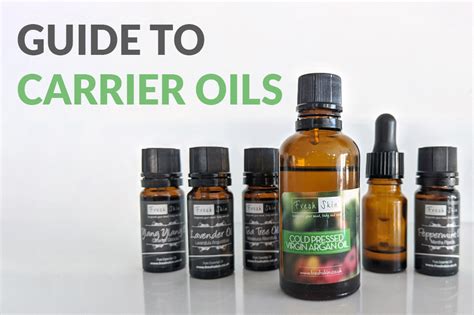Unleashing the Power of Essential Oils with Carrier Oils
Essential oils have captivating aromas and therapeutic properties. However, their potent nature requires dilution before topical application. Enter carrier oils, the gentle guardians that escort essential oils onto your skin, providing a safe and effective delivery system.

Benefits of Carrier Oils for Essential Oils
- Enhanced Absorption: Carrier oils bypass the skin’s barrier, allowing essential oils to penetrate deeper, maximizing their therapeutic effects.
- Reduced Irritation: The soothing properties of carrier oils counteract the potential irritating effects of certain essential oils, particularly for sensitive skin.
- Prolonged Release: Carrier oils act as a slow-evaporating reservoir, extending the lifespan of essential oil applications.
- Synergistic Effects: The therapeutic benefits of carrier oils complement those of essential oils, offering holistic wellness.
Choosing the Right Carrier Oil for You
Selecting the optimal carrier oil depends on your skin type, desired therapeutic outcomes, and personal preferences. Consider the following factors:
- Skin Type: Oily skin may prefer lighter oils like jojoba or hazelnut, while dry skin may benefit from heavier oils like avocado or almond.
- Absorption Rate: Fractionated coconut oil, with its rapid absorption rate, is ideal for quick-acting applications.
- Aroma: While carrier oils generally have a neutral aroma, some possess distinctive scents, like rosehip’s earthy notes or argan’s nutty fragrance.
- Comedogenicity: Choose non-comedogenic carrier oils that do not clog pores, such as jojoba or grape seed oil.
Table 1: Common Carrier Oils for Essential Oils
| Carrier Oil | Skin Type | Absorption Rate | Key Benefits |
|---|---|---|---|
| Jojoba Oil | All | Medium | Simulates sebum production, balancing oily skin |
| Coconut Oil (Fractionated) | All | Rapid | Antibacterial, moisturizing, easily absorbed |
| Argan Oil | Dry | Slow | Rich in vitamin E and antioxidants, regenerating |
| Almond Oil | Dry, Sensitive | Medium | Soothing, emollient, ideal for body massages |
| Sweet Almond Oil | All | Medium | Gentle, nourishing,适合婴儿护肤 |
Innovative Applications of Carrier Oils
Beyond traditional topical uses, carrier oils unlock a world of creative applications:
- Carrier Oil Perfume: Blend essential oils with a carrier oil to create a natural and customizable perfume.
- Carrier Oil Body Scrub: Exfoliate and moisturize simultaneously by combining essential oils with a carrier oil and sugar or salt.
- Carrier Oil Hair Mask: Revitalize hair by massaging a mixture of essential oils and a carrier oil into the scalp.
- Carrier Oil Bath Salts: Elevate your bath experience by adding a few drops of essential oils to a carrier oil and sprinkling the mixture into the bathwater.
Table 2: Carrier Oils for Specific Health Concerns
| Carrier Oil | Health Concern | Key Benefits |
|---|---|---|
| Lavender Oil | Anxiety, Stress | Calming, sedative |
| Peppermint Oil | Headaches, Fatigue | Cooling, invigorating |
| Eucalyptus Oil | Respiratory Issues | Expectorant, decongestant |
| Tea Tree Oil | Acne, Fungal Infections | Antibacterial, antifungal |
Common Mistakes to Avoid
- Over-Dilution: Diluting essential oils too much can weaken their therapeutic effects. Aim for a dilution ratio of 2-5% for topical applications.
- Using Undiluted Essential Oils: Applying undiluted essential oils can cause irritation or burns. Always dilute essential oils with a carrier oil before topical use.
- Choosing the Wrong Carrier Oil: Opting for a carrier oil that does not suit your skin type or therapeutic needs can compromise the effectiveness of essential oils.
- Ignoring Safety Precautions: Pregnant women, children, and individuals with certain health conditions may need to exercise caution when using essential oils. Consult a healthcare professional before applying essential oils.
Frequently Asked Questions
1. How often should I use essential oils with a carrier oil?
The frequency of use depends on the essential oil and your individual needs. However, most essential oils can be applied once or twice daily, diluted with a carrier oil.
2. Can I mix different essential oils in a carrier oil?
Yes, you can blend multiple essential oils in a carrier oil to create a customized synergy. Start with a small amount of each essential oil and gradually adjust the ratios until you find a combination that works for you.
3. How do I create a carrier oil perfume?
To make a carrier oil perfume, add 10-15 drops of essential oils per 10ml of carrier oil. Experiment with different essential oil combinations to create a signature scent.
4. Is it safe to use essential oils with a carrier oil on babies?
While essential oils can be beneficial for children, they should be diluted properly and used with caution. Consult a healthcare professional before using essential oils on babies.
Table 3: Dilution Ratios for Topical Applications
| Age | Dilution Ratio |
|---|---|
| Infants (0-6 months) | 0.5% |
| Children (6-12 years) | 1% |
| Adolescents (13-18 years) | 2% |
| Adults | 2-5% |
Table 4: Essential Oils to Avoid During Pregnancy and Breastfeeding
| Essential Oil | Reason |
|---|---|
| Cinnamon Bark | Uterine stimulant |
| Clary Sage | May induce labor |
| Hyssop | May cause uterine contractions |
| Juniper Berry | Can be toxic to kidneys |
| Pennyroyal | May cause miscarriage |
Conclusion
Essential oil carrier oils are the unsung heroes of aromatherapy, unlocking the full potential of essential oils. By understanding the benefits, choosing the right carrier oil, and observing proper safety measures, you can transform your essential oil experience into a transformative journey of wellness and well-being.
